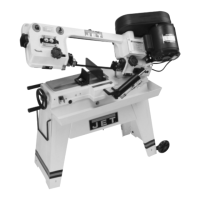13
9.11 Blade break-in procedures
New blades are very sharp, and therefore have a
tooth geometry which is easily damaged if a careful
break-in procedure is not followed. You may want
to consult manufacturers' literature for break-in of
specific blades on specific materials. However, the
following break-in procedure will be adequate for
break-in of JET supplied blades.
1. Clamp a 2 inch or larger work piece in the saw.
2. Set the blade speed to its required speed.
See Changing blade speeds.
3. If possible, use a cutting fluid during break-in
cuts.
4. Set the hydraulic control valve just enough to
begin a very light cut on the work piece.
5. When the blade has cut 1/3rd of the way
through the work piece, increase the feed rate
slightly and allow the blade to complete the
cut.
6. Make another cut on the stock. Begin the cut
with the control valve set at the same feed rate
you finished the first cut.
7. 1/3rd of the way through the second cut,
increase the rate of feed until the blade is
cutting at its most efficient rate. See Evaluating
cutting efficiency.
8. Allow the saw to complete this second cut.
The blade can now be considered ready for
regular service.
Note: There are flanges on the back face of the
drive and idler wheels to prevent the blade from
"walking off" the back of the wheels. If these
flanges are damaged the wheels must be replaced.
Check blade tracking whenever changing a blade
to be certain the blade is positioned correctly on
the wheels. See Blade tracking in the Maintenance
section of this manual
9.12 Changing blades
1. Disconnect the saw from its electric power
source.
2. Lift the saw arm to its full up position and lock
it up using the hydraulic feed control knob.
NOTE: Use the handle on the arm to lift the
arm. Never use any other part of the arm as a
lifting method.
3. Remove the blade guard cover thumb screw
and open the cover.
4. Loosen the blade tension knob until the blade
comes off of its wheels.
5. Using leather gloves to protect from cuts, slip
the blade out of the blade guide bearings and
off of the saw.
6. Examine the drive and idler wheels for
evidence of wear on the flanges. If the flanges
are wearing, the blade is misadjusted. See
Blade tracking for correcting this condition.
7. Put a replacement blade in the blade guide
bearings and loop the ends of the blade over
the drive and idler wheels.
NOTE: The saw blade teeth must point in the
direction of travel. See Figure 16.
8. Use the blade tension knob to put tension on
the blade until it no longer slips on the wheels.
NOTE: Do not overtighten the blade. Just
increase tension until the blade does not slip
on the wheels.
9. Close the blade guard cover and replace and
tighten the thumb screw.
10. Reconnect the saw to its electrical power
source.
Figure 16: Corrrect tooth direction when replacing
blade.
9.13 Adjusting blade guides
Refer to Figure 1.
Both the left and right blade guides should be
positioned as close as possible to the left and right
edges of any work piece being cut. This provides
support to the blade so it can make a straight cut.
1. Loosen the blade guide knobs.
2. Slide the blade guides to the correct spacing.
3. Tighten the lock knobs securely.
10.0 Maintenance
NOTE: The following maintenance operation
requires the services of a licensed electrician.
10.1 Motor replacement
1. Perform steps 2 through 5 in Changing blade
speeds, sect. 9.7.
2. Remove the drive belt.
3. Remove the set screw which retains the motor
drive pulley to the motor shaft.
4. Pull the pulley off of the motor drive shaft.
5. BEING CERTAIN THAT THE SAW HAS BEEN
SAFELY DISCONNECTED FROM THE
SERVICE BRANCH, open the motor terminal

